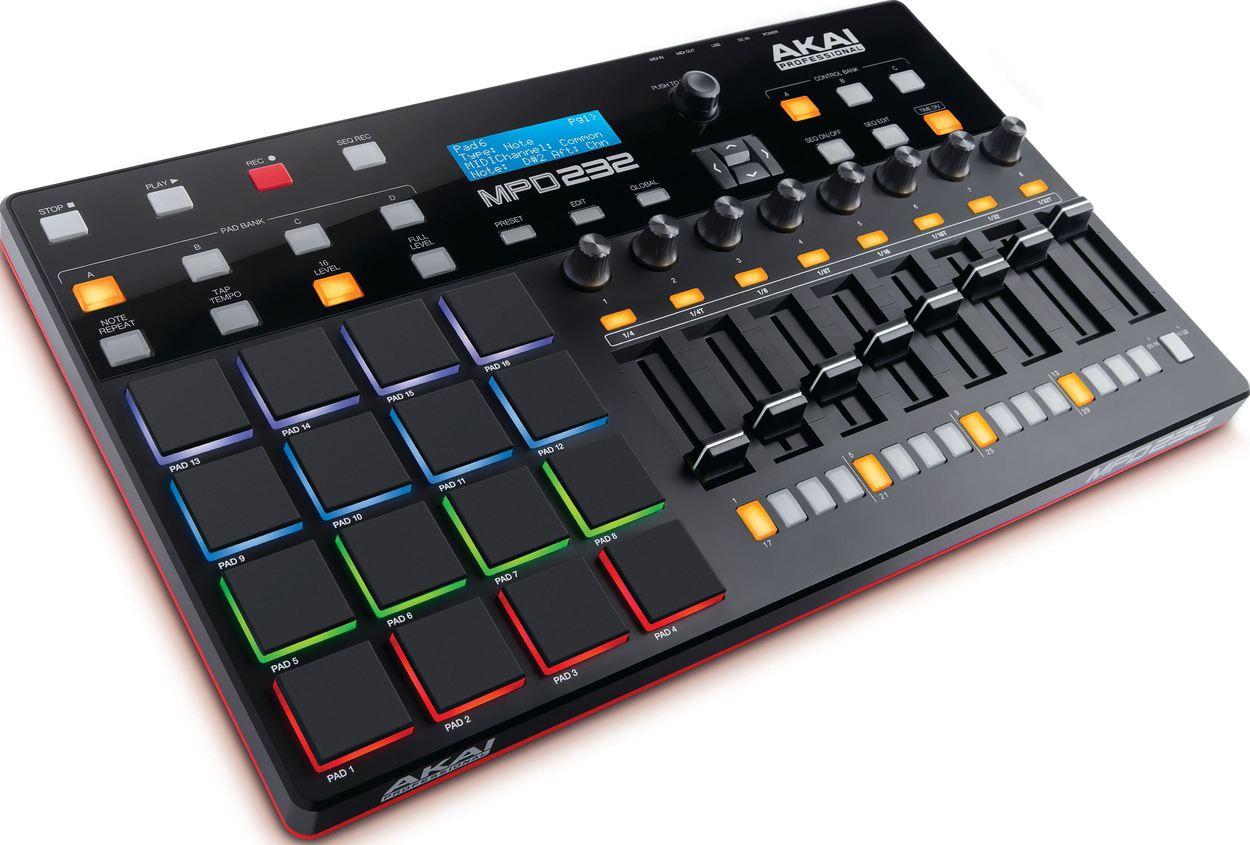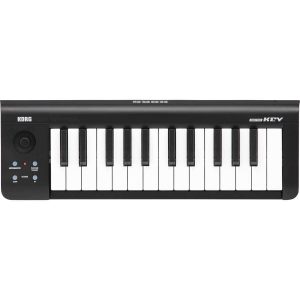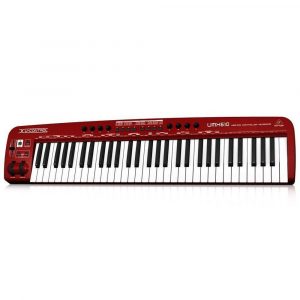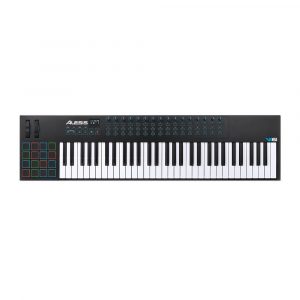Akai MPD232
$147.99
Unleash your creativity with the Akai MPD232 midi keyboard and experience unparalleled control over your music production.
Compare
Description
The Akai MPD232 MIDI device is a powerful hardware controller designed specifically for music producers, musicians, and DJs. This device is the perfect combination of a traditional drum machine coupled with advanced MIDI triggering technology, allowing for an intuitive and dynamic production experience.
The MPD232 is housed in a durable and compact housing and features 16 thick and responsive MPC-style pads that are backlit with RGB LED lighting. These pads are highly customizable and can be programmed to trigger samples, loops, and even to control software-based instruments.
One of the standout features of the MPD232 is its ability to control up to 64 assignable presets and up to eight virtual banks, making it possible to control multiple plugins, software instruments, and effects simultaneously. This gives producers a new level of musical control and endless possibilities for creativity.
To further increase its appeal, Akai has also included an onboard control section that features eight faders, eight knobs, and eight buttons. These can be assigned to control parameters such as volume, pan, and effect levels, giving producers even more control of their music.
The device is also equipped with a built-in step sequencer, which allows for precise and complex rhythm programming. The sequencer also features swing settings, note repeat, and a variety of other options that allow for complete control of the rhythmic components of your tracks.
To connect the MPD232 to your computer, it features a USB port which also provides power to the device. The MPD232 is also MIDI-compatible, ensuring it will work with all MIDI-enabled software.
Lastly, the MPD232 is bundled with Akai’s MPC Essentials software, which includes an extensive library of samples, loops, and plugins. It also integrates seamlessly with most popular digital audio workstations, making it easy to incorporate the MPD232 into your existing set up.
In conclusion, the Akai MPD232 is a versatile and dynamic hardware controller that offers producers complete control over their music. Whether you’re producing beats, programming drum patterns, or controlling software instruments, the MPD232’s customizable pads, faders, knobs, and buttons allow for endless creative possibilities. Overall, the MPD232 is a great investment for any musician or music producer looking to elevate their game to the next level.
Akai MPD232 properties
| Product name |
MPD232 |
| Brand |
Akai |
| Type |
Keyboard Instruments |
| Keyboard Instrument |
MIDI Keyboard |
| Drawbars/Sliders |
Yes |
| Pads |
Yes |
| Rotary Controls |
Yes |
| Colour |
Black |
Frequently Asked Questions:
How does the Akai MPD232's velocity-sensitive pads and assignable controls enhance its functionality as a MIDI performance controller?
The Akai MPD232's velocity-sensitive pads and assignable controls significantly enhance its functionality as a MIDI performance controller by providing the ability to capture the nuances and dynamics of human performance. Velocity sensitivity enables the user to play with expression, allowing for the creation of more lifelike and engaging performances. The assignable controls offer additional flexibility and customization, enabling users to map various functions such as effects parameters, synthesizer settings, or DAW shortcuts directly to the controller's knobs, faders, and switches. Overall, these features make the MPD232 a powerful and versatile tool for live performance and studio production alike.
How does the Akai MPD232's MIDI I/O interface enable seamless integration into various DAW software and external MIDI devices?
The Akai MPD232 comes equipped with a MIDI I/O interface that enables it to communicate seamlessly with various Digital Audio Workstations (DAW) software and external MIDI devices. The MIDI In and Out ports allow you to connect the MPD232 directly to your computer running DAW software, such as Ableton Live, Logic Pro X, FL Studio, or GarageBand, using a standard MIDI cable (sold separately). This allows you to trigger virtual instruments, record MIDI performances, and send MIDI data to other external MIDI devices. With its versatile MIDI I/O interface, the Akai MPD232 is an excellent choice for producers, composers, and performers who want a high-quality and affordable MIDI controller that integrates seamlessly into their existing setup.
How do I correctly connect and configure the Akai MPD232 MIDI pad controller to my digital audio workstation (DAW) for optimal performance in live and studio settings?
Make sure your DAW is compatible with the MPD232. Most major DAWs like Ableton, Logic Pro, FL Studio, and Reason are supported by Akai's MIDI pad controllers. Connect the MPD232 to your computer using a USB cable. The USB port is located on the back panel of the device. You should feel a connection between the two devices when plugged in properly. Launch your DAW software and go to the preferences or settings menu. In Ableton Live, for instance, select "MIDI Sync" from the Preferences window. Here, you can choose the MPD232 as your master clock source. This is important if you're using the controller in a live performance setting where synchronization is crucial. You may also want to adjust the MIDI port settings to ensure that the MPD232 is recognized by your DAW software. In Ableton Live, for example, select "Preferences" from the menu and click on the "MIDI/Sync" tab. Here, you can set the device as an input and output MIDI source. Next, go to your DAW's MIDI mapping section. This is where you'll be able to assign specific functions and parameters to each pad on the controller. Follow the manufacturer's guide for your software to map out the pads. For example, in Ableton Live, select "Preferences" from the menu and click on the "MIDI Mapping" tab. Here, you can view a graphical representation of all the MIDI controllers connected to your computer, as well as their respective functions. Once you've assigned functions to each pad, you're ready to use the MPD232 in your live or studio settings. In Ableton Live, for example, you can use the "Session View" and "Arrangement View" to control various elements of your performance or mixes. Finally, it's recommended to regularly update the firmware on your MPD232 using Akai's official software utility. This ensures that you're using the most up-to-date version of the device and can resolve any bugs or compatibility issues with your DAW software.
How do I connect and program external MIDI devices using the Akai MPD232's MIDI I/O ports?
Make sure your external MIDI device is powered on and connected to one of the MIDI input or output ports on the back of the MPD232. The MPD232 has two MIDI input ports (IN 1 and IN 2) and two MIDI output ports (OUT 1 and OUT 2). Press the "SETUP" button located in the top left corner of the MPD232's control panel. The display will show "SETUP". Use the navigation buttons to select "MIDI SETTINGS" from the main menu, then use the encoder knob to scroll down to "MIDI I/O". Press the encoder knob to enter this section. Select the MIDI port you want to connect your external device to by pressing the corresponding button on the MPD232's control panel (e. IN 1" if you connected your device to that port). The display will show the selected port, such as "MIDI IN 1". Press the encoder knob again to enter the submenu for the selected MIDI port. You'll see options like "CHANNEL" (for selecting which MIDI channel messages from the external device should be sent to the MPD232), "PROGRAM BANK MSB", and "PROGRAM BANK LSB". Use the navigation buttons to select these options as needed for your specific setup. Follow a similar process for any additional external devices you want to connect and program, selecting their corresponding ports and adjusting their settings in the MPD232's MIDI I/O menu. Once you've set up all of your external devices, be sure to save your changes by pressing the "WRITE" button located in the top right corner of the control panel. The display will confirm that your settings have been saved. You can now use your external MIDI devices with the MPD232! Note that you may need to adjust settings on the external device itself, such as selecting the correct MIDI channel or program bank, depending on how it's configured. Consult the manual for your specific device for more information.
What is the maximum number of MIDI channels that can be sent simultaneously from the Akai MPD232?
The Akai MPD232 is a MIDI controller, and as such, it can send any number of MIDI messages on any available MIDI channel. However, the actual number of channels it can send data to at once depends on the device's buffer size. The Akai MPD232 typically has a buffer size of 64 bytes, which means that if you're sending a steady stream of MIDI notes or other controllers, there will be an upper limit on how many different notes or controller values can be sent out in a single MIDI message. However, most applications and devices don't need to send out more than 16 channels worth of data at once. It's also worth noting that the Akai MPD232 supports up to 8 MIDI ports (1-8), but you'll typically only use one or two for sending data. So to answer your question, there is no maximum number of MIDI channels that can be sent from a single output port on the Akai MPD232, unless we're talking about the actual buffer size which would limit it to around 16 different channels worth of data at any given time. But if you need to send out more than 16 different channels, you could always use one of the other ports (1-7) to send the additional MIDI messages.
Before you buy Akai MPD232







Joshua Schmidt –
As Joshua Schmidt, I am thrilled to share my recent experience with purchasing a game-changing addition to my music production setup – the Akai MPD232. In the chilly month of November, I ventured into an online shop and came across this marvelous MIDI keyboard that has transformed the way I create music.
The Akai MPD232 has significantly impacted my musical environment by providing me with a wealth of creative possibilities. Its 25 velocity-sensitive pads, 16 backlit MPC-style performance pads, and eight endless encoders make it an incredibly versatile tool for composing, performing, and producing music. The ability to assign different functions to each pad and encoder has opened up new dimensions of expression and experimentation in my workflow.
One of the most striking features that sets the Akai MPD232 apart from other MIDI keyboards is its compatibility with various software and hardware platforms, including Ableton Live, Logic Pro X, and Reason+. This versatility has enabled me to seamlessly integrate it into my existing setup without any compatibility issues.
The economy of Lewisville has seen a significant rise in online business in recent years, and the Akai MPD232 is a testament to this trend. Purchasing this product online not only saved me time and money but also gave me access to a wider range of retailers and deals than I would have found in-store.
For anyone interested in buying a MIDI keyboard, I recommend doing thorough research on the brand and model you’re considering. Consider factors such as compatibility with your preferred software or hardware, ease of use, and the overall value for money. It’s also essential to read reviews from other customers who have had experience with the product to gauge its reliability and durability.
In conclusion, I am incredibly satisfied with my purchase of the Akai MPD232 and would recommend it wholeheartedly to anyone looking to enhance their music production capabilities. Its versatility, compatibility, and user-friendliness have made it an indispensable addition to my setup, and I am excited to see what new horizons of creativity it will unlock in the future.
Today’s news has been dominated by a global pandemic that has affected all industries, including music production and online business. In this challenging time, it’s essential to support small businesses and prioritize self-care as we navigate through unpredictable circumstances. Let us remember to stay connected with our loved ones through music and other creative means, and most importantly, let us remain hopeful and optimistic for a brighter future ahead.